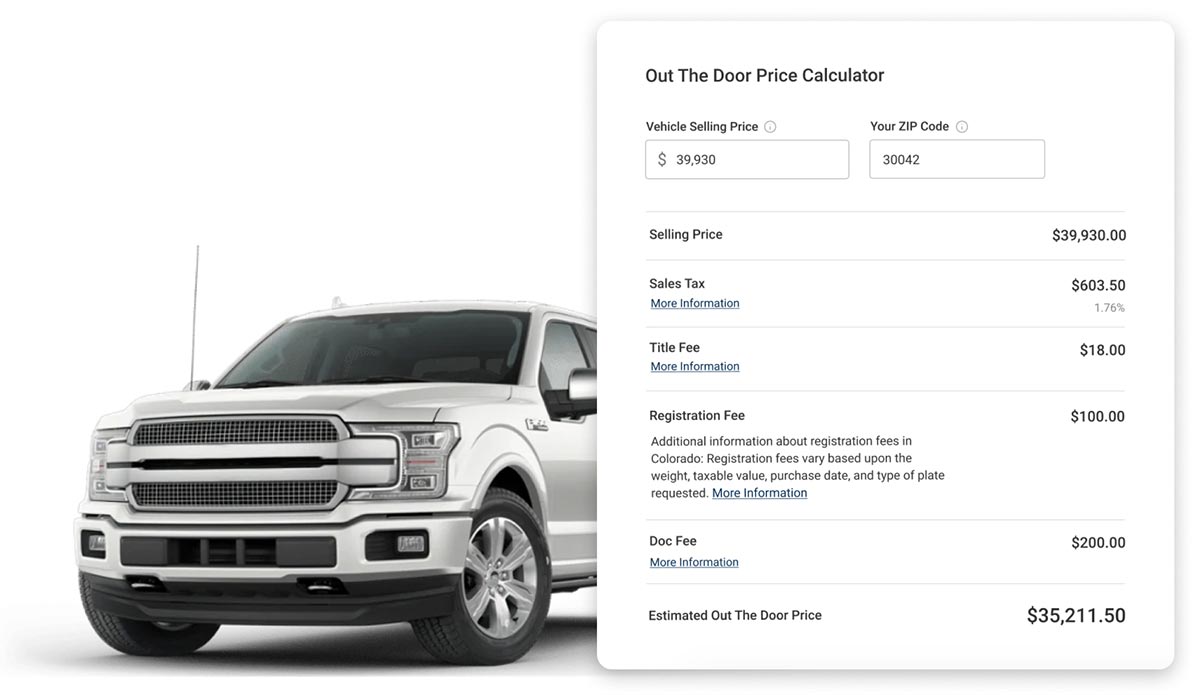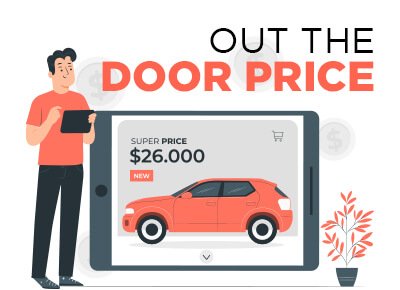Breaking Down the Components of Out the Door Price
The out the door price is comprised of several components, each contributing to the final cost of the vehicle. One of the most significant components is the destination fee, which can range from $500 to $1,000, depending on the manufacturer and the distance the vehicle is transported. This fee is typically non-negotiable, but it’s essential to understand that it’s included in the out the door price.
Taxes are another critical component of the out the door price. These can vary significantly depending on the state and locality, with some states imposing higher taxes than others. For example, California has a sales tax rate of 7.25%, while Oregon has no sales tax. Understanding the tax implications is crucial to accurately calculating the out the door price.
Title fees and registration fees also contribute to the out the door price. These fees vary by state, but they can add hundreds of dollars to the final cost. In some states, title fees can be as high as $200, while registration fees can range from $50 to $500. It’s essential to research these fees and factor them into the out the door price calculation.
Other components that may be included in the out the door price are documentation fees, prep fees, and advertising fees. While these fees may seem insignificant, they can add up quickly. For instance, documentation fees can range from $100 to $500, while prep fees can be as high as $1,000. Understanding these fees and how they contribute to the out the door price is vital to making an informed purchasing decision.
By breaking down the components of the out the door price, buyers can gain a deeper understanding of the true cost of the vehicle. This knowledge can help buyers negotiate with dealerships and make more informed decisions about their purchase. In the next section, we will provide a step-by-step guide on how to calculate the out the door price, including tips on how to research and estimate costs.
How to Calculate Out the Door Price: A Step-by-Step Guide
Calculating the out the door price of a vehicle can seem daunting, but it’s a crucial step in understanding the true cost of the vehicle. To calculate the out the door price, follow these steps:
Step 1: Determine the base price of the vehicle. This is the price of the vehicle without any additional features or options. The base price can be found on the vehicle’s invoice or on the manufacturer’s website.
Step 2: Add the cost of any additional features or options. This can include items such as navigation systems, sunroofs, or upgraded audio systems. The cost of these features can be found on the vehicle’s invoice or on the manufacturer’s website.
Step 3: Calculate the destination fee. This fee is typically a flat rate that is charged by the manufacturer to transport the vehicle from the factory to the dealership. The destination fee can range from $500 to $1,000, depending on the manufacturer and the distance the vehicle is transported.
Step 4: Calculate the taxes. Taxes can vary significantly depending on the state and locality. Research the tax rate in your area and calculate the taxes based on the base price of the vehicle plus any additional features or options.
Step 5: Add the title fees and registration fees. These fees vary by state, but they can add hundreds of dollars to the final cost. Research the fees in your state and add them to the calculation.
Step 6: Add any other fees. This can include fees such as documentation fees, prep fees, and advertising fees. These fees can add up quickly, so it’s essential to research them and factor them into the calculation.
For example, let’s say you’re purchasing a Toyota Camry with a base price of $25,000. You add a navigation system for $1,000 and a sunroof for $500. The destination fee is $800, and the taxes are 7.25% of the total price. The title fees and registration fees are $200 and $100, respectively. The total out the door price would be:
$25,000 (base price) + $1,000 (navigation system) + $500 (sunroof) + $800 (destination fee) + $1,806 (taxes) + $200 (title fees) + $100 (registration fees) = $29,406
By following these steps, you can calculate the out the door price of a vehicle and gain a better understanding of the true cost of the vehicle. This knowledge can help you make a more informed purchasing decision and avoid any surprises at the dealership.
Out the Door Price vs. MSRP: What’s the Difference?
When researching a vehicle, you may come across two different prices: the out the door price and the MSRP (Manufacturer’s Suggested Retail Price). While both prices are important, they serve different purposes and can impact the car buying process in distinct ways.
The MSRP is the price that the manufacturer recommends the vehicle be sold for. This price is typically listed on the vehicle’s sticker and is used as a starting point for negotiations. However, the MSRP does not include additional costs such as destination fees, taxes, and title fees, which can add up quickly.
The out the door price, on the other hand, is the total price of the vehicle, including all additional costs. This price is the actual amount that the buyer will pay for the vehicle, and it’s essential to understand the difference between the MSRP and the out the door price to avoid any surprises at the dealership.
For example, let’s say you’re looking at a Toyota Camry with an MSRP of $25,000. However, the out the door price is $28,000, which includes destination fees, taxes, and title fees. If you’re not aware of the difference between the two prices, you may be surprised by the additional costs when you arrive at the dealership.
Understanding the difference between the MSRP and the out the door price can help you make a more informed purchasing decision. By knowing the total cost of the vehicle, you can better negotiate with the dealer and avoid any unexpected costs. In the next section, we’ll provide tips on how to negotiate the out the door price with a dealer.
Negotiating the Out the Door Price: Tips and Strategies
Negotiating the out the door price with a dealer can be a daunting task, but it’s essential to get the best deal possible. Here are some tips and strategies to help you negotiate the out the door price:
Research, research, research: Before you start negotiating, research the market value of the vehicle you’re interested in. Use tools like Kelley Blue Book or Edmunds to determine the fair market price of the vehicle. This will give you a basis for your negotiation.
Know the dealer’s costs: Understand the dealer’s costs, including the invoice price, destination fees, and other expenses. This will help you make a stronger case for a lower price.
Don’t show your hand: Don’t let the dealer know how much you want the vehicle or how much you’re willing to pay. Keep your cards close to your chest and let the dealer make the first offer.
Make a strong case: Use the research you’ve done to make a strong case for a lower price. Point out any flaws in the vehicle or any discounts you’ve found. Be respectful and professional, but firm in your negotiation.
Be willing to walk away: If the dealer is not willing to meet your price, be willing to walk away. This shows the dealer that you’re not desperate and may cause them to come back with a better offer.
Use competition to your advantage: If you’ve found a better price at a competing dealership, use it to your advantage. Let the dealer know that you’ve found a better price and ask them to match it.
Don’t fall for extras: Dealers may try to sell you additional features or services, such as extended warranties or maintenance plans. Make sure you carefully consider whether you really need these extras and don’t fall for high-pressure sales tactics.
Get everything in writing: Once you’ve agreed on a price, make sure everything is in writing. This includes the price, any trade-in value, and any additional features or services.
By following these tips and strategies, you can negotiate the out the door price with confidence and get the best deal possible.
Real-World Examples: Out the Door Prices for Popular Vehicles
To illustrate the concept of out the door price, let’s look at some real-world examples of popular vehicles. We’ll examine the out the door prices for the Toyota Camry and Honda Civic, two of the best-selling vehicles in the US.
Toyota Camry:
The Toyota Camry is a mid-size sedan that is known for its reliability and fuel efficiency. The MSRP for the 2022 Toyota Camry starts at around $25,000. However, the out the door price can vary depending on the trim level, options, and location.
For example, a Toyota Camry XLE with a V6 engine and leather seats may have an out the door price of around $32,000 in California. This includes the MSRP, destination fees, taxes, title fees, and registration fees.
Honda Civic:
The Honda Civic is a compact car that is known for its reliability and fuel efficiency. The MSRP for the 2022 Honda Civic starts at around $20,000. However, the out the door price can vary depending on the trim level, options, and location.
For example, a Honda Civic EX-L with a V6 engine and leather seats may have an out the door price of around $28,000 in New York. This includes the MSRP, destination fees, taxes, title fees, and registration fees.
As you can see, the out the door price for these vehicles can vary significantly depending on the location and trim level. It’s essential to research the out the door price for the specific vehicle you’re interested in to get an accurate estimate of the total cost.
By understanding the out the door price, you can make a more informed decision when purchasing a vehicle. In the next section, we’ll discuss common mistakes to avoid when dealing with out the door price.
Common Mistakes to Avoid When Dealing with Out the Door Price
When dealing with out the door price, there are several common mistakes that buyers can make. Here are some of the most common mistakes to avoid:
Failing to research costs: One of the biggest mistakes buyers can make is failing to research the costs associated with the vehicle. This includes destination fees, taxes, title fees, and registration fees. By not researching these costs, buyers can end up paying more than they expected.
Neglecting to negotiate: Another common mistake is neglecting to negotiate the out the door price. Buyers should always negotiate the price of the vehicle, including the out the door price. By not negotiating, buyers can end up paying more than they need to.
Not understanding the fine print: Buyers should always read and understand the fine print before signing any documents. This includes understanding the out the door price and all the costs associated with it.
Not comparing prices: Buyers should always compare prices at different dealerships and online to ensure they are getting the best deal. By not comparing prices, buyers can end up paying more than they need to.
Not considering additional costs: Buyers should always consider additional costs such as maintenance, insurance, and fuel costs when calculating the out the door price. By not considering these costs, buyers can end up paying more than they expected.
By avoiding these common mistakes, buyers can ensure they are getting the best deal possible and avoid any surprises when it comes to the out the door price.
Conclusion: Taking Control of the Car Buying Process with Out the Door Price
Understanding the out the door price is a crucial step in the car buying process. By knowing the true cost of the vehicle, buyers can make informed decisions and avoid any surprises at the dealership. In this article, we have discussed the concept of out the door price, its significance in the car buying process, and how it differs from other pricing terms like MSRP and invoice price.
We have also provided a step-by-step guide on how to calculate the out the door price, including tips on how to research and estimate costs. Additionally, we have discussed common mistakes to avoid when dealing with out the door price, such as failing to research costs or neglecting to negotiate.
By taking control of the car buying process and understanding the out the door price, buyers can ensure they are getting the best deal possible. Remember to research costs, compare prices, and negotiate the out the door price to get the best deal. Don’t be afraid to walk away if the deal isn’t right, and always read and understand the fine print before signing any documents.
By following these tips and strategies, buyers can take control of their purchase and drive away in their new vehicle with confidence. Remember, the out the door price is the true cost of the vehicle, and understanding it is key to making an informed decision.
Conclusion: Taking Control of the Car Buying Process with Out the Door Price
In conclusion, understanding the out the door price is crucial in the car buying process. It’s the total cost of the vehicle, including all fees and taxes, and it’s essential to know this price to make an informed decision. By researching, calculating, and negotiating the out the door price, buyers can take control of their purchase and avoid any surprises at the dealership.
Remember, the out the door price is not just the sticker price of the vehicle. It includes destination fees, taxes, title fees, and registration fees, which can add up quickly. By understanding these costs and how they impact the out the door price, buyers can make a more informed decision and avoid any surprises.
Additionally, negotiating the out the door price is key to getting the best deal possible. By researching the market value of the vehicle, comparing prices, and making a strong case for a better deal, buyers can negotiate a lower out the door price and save money.
In summary, understanding the out the door price is essential in the car buying process. By researching, calculating, and negotiating the out the door price, buyers can take control of their purchase and avoid any surprises at the dealership. Remember to always research the market value of the vehicle, compare prices, and negotiate the out the door price to get the best deal possible.







